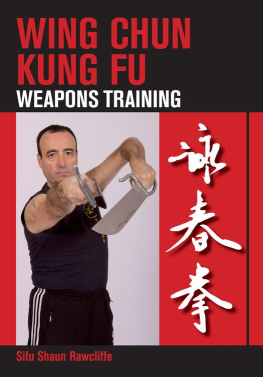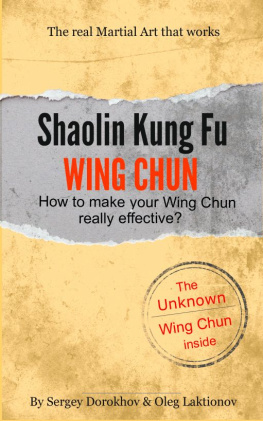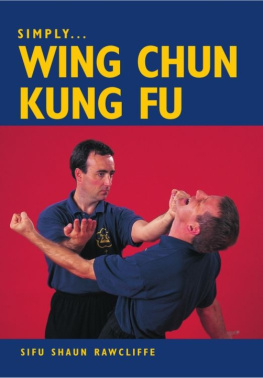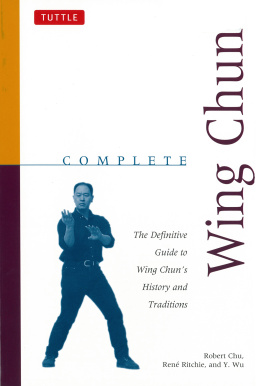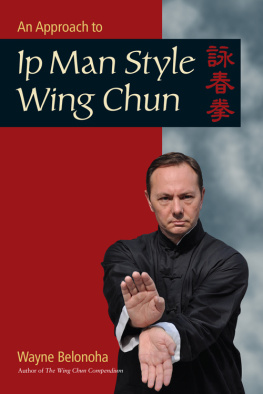This book would have been impossible to write without the support and inspiration of my colleagues, friends, and family.
Thanks to all my Kung Fu brothers, regardless of what martial arts they practiced.
Getting Started
Your cry for help went unanswered. No one is coming. You are on your own. Deal with it.
What is your life worth? Priceless? Then you are going to fight tooth and nail to preserve it. Your life and/or your loved ones are worth protecting and you should project that attitude to those around you. As Bruce Lee said in the movie Game of Death, Fighting without fighting is the best defense." So dont tempt fate, avoid dangerous places whenever possible. However, when a situation arises that you truly cannot avoid, defending yourself is the most logical course of action. When out in public, be safety conscious. Look around, check your surroundings, keep your head up, and walk with a confident stride . This tells a potential predator that you are more likely to see him coming and will resist. Without that kind of attitude, you are prey, a target.
Awareness and Prevention
Do not be blind to the world around you. Prevent crimes by being aware of who and what is around you. Use your eyes, ears, and common sense. Yes, use your brain. Avoid questionable areas, like dark alleys, dark parking lots, trees, shrubs, etc. Stay near lighted locations, such as street lights, lamp posts. I keep on telling my kids Dont put yourself in a situation that you cant get out of. This is absolutely true. Dont be in a situation where you have to defend yourself, dress appropriately for a given occasion. Dont flash expensive jewelry. Simply put Dont invite trouble. When working late at night, ask a friend or security guard to walk with you to your car, elevator, stairway. Have your car keys ready before you step out to the parking lot, look around, be alert. Check the back of the car before going in. Be aware while taking out the garbage, or walking the dog. Let someone know where you are going and dont be afraid to communicate this to someone. Almost everyone has a cell phone, use it, take pictures, email it to your account, etc.
In doesn't matter how good you are, if you are caught unaware and get sucker punched or hit from the back. You are going down.
What we are born with
Most women will look at you strangely when you say Women are weaker than Men. If you value your life, you better follow it up quickly with But women are smarter than men. Phew Now you are safe. (I can see those smiles ) Believe me, I know what I am talking about. I live with four women, my mother-In-law, my wife, and my two daughters. The toilet seat is always down in my house.
Lets be serious though. By nature, women are smaller and weaker than men. But there are advantages to being small and weak. One of the advantages, in my opinion, is that you are using your brain instead of relying on brute strength as most of us men do. You will understand what I mean as you read further.
In the last chapter, you will see some things that you could do to compensate for being weaker.
We are dealing with humans here, not some aliens from outer space with six limbs, or monster with abnormal strength, or vampires that can suck you dry (for real?). What I am trying to say is that we are dealing with fellow humans with two arms, two legs and we know how they work. So let us start with this question - What do we have that we can use as a weapon?
Hands fist, palm, forearm, elbow, fingers
Legs knee, foot
Body shoulder, hip, whole body weight
Head yes as in head butt
Mouth screaming, biting, spitting
The Seizing Art of Chin (Qin) Na
If it is to be, it is up to me - Schuller
You might ask what is the difference between Qin Na and Chin Na. Well, they are the same. Qin Na is Pinyin1, which is a romanticized spelling system and adopted standard by People's Republic of China. "Q" is pronounce "ch" as in cheese. Chinese words are combined to create new words. Qin or Chin in Chinese means "to seize or to catch". While Na "means "to hold or to control". Hence Qin Na or Chin Na literally translated as "to seize and control". Almost all martial arts style have Qin Na incorporated with their specific techniques. This is particularly true in Southern style of Chinese Martial arts which specialize more in hand techniques as compared to Northern style which uses long range attacks and kicking techniques.
Qin Na can be grabbing Qin Na where we seize and lock opponents joints or muscles/tendons. Pressing Qin Na where we press the Qi cavities to numb our opponents limbs and Striking Qin Na, where we strike vital points. In this book we will limit our discussion to grabbing Qin Na. We will also use Qin Na techniques in the next chapter - Defense Against a Grab.
"Finger Qin Na"
We don't care how big or strong our opponents are, once we have them in Finger Qin Na, we own them. The fight is over. Please be careful doing this technique. Remember the Golden Rule - Do not hurt your partner. So take it slow and easy. I remember when we were doing this for three straight days in Dr Yang Wjing Ming's seminar. Our hands and fingers were so sore that we could barely clench our fists on the third day. Now in a real-life situation, you do this quickly and with no mercy, after all, it will be your life which is at stake. So you press, bend, and rip giving your assailant the pain that he deserves for messing with you.
The next series of pictures shows both the correct and incorrect way of applying finger Chin Na. Among our five (5) fingers, the weakest is the pinky and each finger is stronger as you move to the thumb. Though there is nothing to stop you from applying Chin Na to all five fingers, usually you pick two or three of the weakest ones. In either case you need to apply it correctly.
Your goal in this case is to bend your opponent's fingers backward, hence your grasping hand should not go beyond the finger joint, that way there is no blockage to fully bend your opponent's fingers as you apply pressure.
Pinyin1 - Pinyin system, developed in Mid-1920's by People's Republic of China, is the current standard in translating Chinese text and been used by United States government, United Nations, and most of the world's media.


